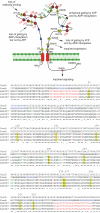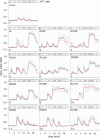Activation of the P2X7 ion channel by soluble and covalently bound ligands
- PMID: 19255877
- PMCID: PMC2686825
- DOI: 10.1007/s11302-009-9135-5
Activation of the P2X7 ion channel by soluble and covalently bound ligands
Abstract
The homotrimeric P2X7 purinergic receptor has sparked interest because of its capacity to sense adenosine triphosphate (ATP) and nicotinamide adenine dinucleotide (NAD) released from cells and to induce calcium signaling and cell death. Here, we examine the response of arginine mutants of P2X7 to soluble and covalently bound ligands. High concentrations of ecto-ATP gate P2X7 by acting as a soluble ligand and low concentrations of ecto-NAD gate P2X7 following ADP-ribosylation at R125 catalyzed by toxin-related ecto-ADP-ribosyltransferase ART2.2. R125 lies on a prominent cysteine-rich finger at the interface of adjacent receptor subunits, and ADP-ribosylation at this site likely places the common adenine nucleotide moiety into the ligand-binding pocket of P2X7.
Figures






References
-
- {'text': '', 'ref_index': 1, 'ids': [{'type': 'DOI', 'value': '10.1046/j.1432-1327.2000.01187.x', 'is_inner': False, 'url': 'https://doi.org/10.1046/j.1432-1327.2000.01187.x'}, {'type': 'PubMed', 'value': '10712584', 'is_inner': True, 'url': 'https://pubmed.ncbi.nlm.nih.gov/10712584/'}]}
- Ziegler M (2000) New functions of a long-known molecule. Emerging roles of NAD in cellular signaling. Eur J Biochem 267:1550–1564 - PubMed
-
- {'text': '', 'ref_index': 1, 'ids': [{'type': 'DOI', 'value': '10.1189/jlb.0802418', 'is_inner': False, 'url': 'https://doi.org/10.1189/jlb.0802418'}, {'type': 'PubMed', 'value': '12629147', 'is_inner': True, 'url': 'https://pubmed.ncbi.nlm.nih.gov/12629147/'}]}
- la Sala A, Ferrari D, Di Virgilio F, Idzko M, Norgauer J, Girolomoni G (2003) Alerting and tuning the immune response by extracellular nucleotides. J Leukoc Biol 73:339–343 - PubMed
-
- {'text': '', 'ref_index': 1, 'ids': [{'type': 'DOI', 'value': '10.1038/nature04886', 'is_inner': False, 'url': 'https://doi.org/10.1038/nature04886'}, {'type': 'PubMed', 'value': '16885977', 'is_inner': True, 'url': 'https://pubmed.ncbi.nlm.nih.gov/16885977/'}]}
- Khakh BS, North RA (2006) P2X receptors as cell-surface ATP sensors in health and disease. Nature 442:527–532 - PubMed
-
- {'text': '', 'ref_index': 1, 'ids': [{'type': 'DOI', 'value': '10.1182/blood.V97.3.587', 'is_inner': False, 'url': 'https://doi.org/10.1182/blood.v97.3.587'}, {'type': 'PubMed', 'value': '11157473', 'is_inner': True, 'url': 'https://pubmed.ncbi.nlm.nih.gov/11157473/'}]}
- Di Virgilio F, Chiozzi P, Ferrari D, Falzoni S, Sanz JM, Morelli A, Torboli M, Bolognesi G, Baricordi OR (2001) Nucleotide receptors: an emerging family of regulatory molecules in blood cells. Blood 97:587–600 - PubMed
-
- {'text': '', 'ref_index': 1, 'ids': [{'type': 'PubMed', 'value': '12270951', 'is_inner': True, 'url': 'https://pubmed.ncbi.nlm.nih.gov/12270951/'}]}
- North RA (2002) Molecular physiology of P2X receptors. Physiol Rev 82:1013–1067 - PubMed
LinkOut - more resources
Full Text Sources

